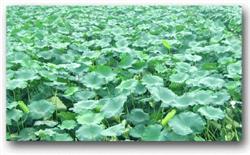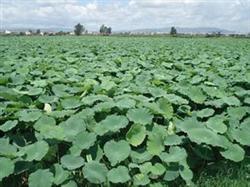Six common diseases of lotus root and their control

First, lotus root brown spot. A common disease in the lotus leaf, which produces light brown spots on the leaves, causing local dryness of the diseased leaves. Prevention and treatment: reasonable close planting to ensure ventilation and light in the lotus root field; appropriate application of phosphorus and potassium fertilizer to improve plant resistance and timely removal of diseased plant residues. Spray 25% carbendazim 600x solution or 75% chlorothalonil 1000 times solution at the initial stage of the disease. Second, black spot of lotus root. Brown streak, also known as brown streak, occurs only on the leaves. In severe cases, the disease spots converge and the leaves are withered and yellow. Control: thoroughly remove the diseased and residual leaves in the field in winter and burn them centrally. At the initial stage of the disease, the diseased leaves were removed and sprayed for prevention and treatment. Commonly used 70% methyl topiramate 1000 times solution, or 65% Dysen zinc 600 times solution, or 1 lug 1lux 160mur200 times Bordeaux solution, sprayed once every 10 mi 15 days, a total of 2 Mel 3 times. Third, lotus root rot. Fusarium wilt, also known as Fusarium wilt, infects the underground stem and causes rot. when it is serious, the whole field is withered and yellow, like a fire. Prevention and treatment: seriously diseased fields should be rotated for 2-3 years. Commonly used 70% methyl topiramate 1000 times solution or 75% chlorothalonil 800x solution spray suffocation, cover agricultural film sealed for 24 hours, dry after planting. Turn the lotus root field deeply and apply 150 kilograms of lime per mu. When you get sick, you can mix 0.5 kg of 75% chlorothalonil and 30 kg of dry soil and sprinkle it into the shallow paddy field. Fourth, lotus root streak virus disease. Symptoms can be shown on the damaged lotus leaves and underground rhizomes, with large polygonal to irregular light brown spots on the leaves and dark brown anthrax spots on the rhizome epidermis. Prevention and treatment: select disease-resistant varieties, timely control aphids (transmission vector), spray 1.5% Zhishanling emulsion 1000 times at the initial stage of the disease. Fifth, Fusarium wilt of lotus leaf. The damaged lotus leaves were scorched and withered, which affected the growth of lotus root and reduced yield. Prevention and control: keep the lotus root field clean and prevent oil pollution. Sewage and soapy water can also cause lotus leaves to wither and die. Lotus root is very sensitive to herbicides, and herbicides should never be applied in lotus root fields. 6. Common diseases and insects. There are aphids, large coir moth, pear green moth, brown thorn moth, harmful to standing leaves and buds. It can be sprayed with 90% trichlorfon 800ml 1000 times or 40% dimethoate 2000 times. Water maggots suck the juice from the roots, stems and leaves of lotus roots, causing lotus leaves to turn yellow. once found, they can be killed with lime at a dosage of 10 Mu and 15 kg per mu.
- Prev

Technical methods of seed selection and retention of Lotus Root
(1) selection and breeding. The selection and breeding of lotus root mainly includes asexual seed selection and sexual cross breeding. 1. Asexual selection. China is rich in lotus root germplasm resources, which provides good conditions for asexual selection. In recent years, varieties selected from superior clones include Kexuan 1, Elian 1 and Zhejiang Lake.
- Next

Comprehensive Control of Lotus Root Diseases
First, lotus root brown spot disease is a common disease in lotus leaves, which produces light brown spots on the leaves, causing local dryness of the diseased leaves. Prevention and treatment: reasonable close planting to ensure ventilation and light in the lotus root field; appropriate application of phosphorus and potassium fertilizer to improve plant resistance and timely removal of diseased plant residues. The initial stage of the disease with 25% carbendazim 600 times solution, or 75% chlorothalonil.
Related
- Where is it suitable to grow horseradish in China? it is expected to see the middle altitude horseradish in Alishan.
- How to prevent tomato virus disease reasonably? (Control methods included)
- Many people like to plant towel gourd on the balcony. What are the main points of this method and management?
- What crops can chili peppers be mixed with?
- Fertilization techniques and matters needing attention in Tomato
- What are the grafting techniques for peach seedlings in spring?
- Harm and control methods of root swelling disease of Chinese cabbage
- What are the pests of sweet potatoes? How to prevent and cure it?
- Symptoms, causes and Control methods of navel Rot in Tomato
- The cause of "Cucumber rotten bibcock" in Farmers' planting Cucumber and its Control Plan

